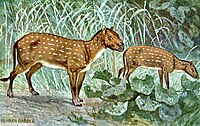User:Abyssal/Portal:Paleogene
IntroductionThe Paleogene Period (IPA: /ˈpeɪli.ədʒiːn, -li.oʊ-, ˈpæli-/ PAY-lee-ə-jeen, -lee-oh-, PAL-ee-; also spelled Palaeogene or Palæogene) is a geologic period and system that spans 43 million years from the end of the Cretaceous Period 66 million years ago (Mya) to the beginning of the Neogene Period 23.03 Mya. It is the first part of the Cenozoic Era of the present Phanerozoic Eon. The earlier term Tertiary Period was used to define the time now covered by the Paleogene Period and subsequent Neogene Period; despite no longer being recognized as a formal stratigraphic term, "Tertiary" still sometimes remains in informal use. Paleogene is often abbreviated "Pg", although the United States Geological Survey uses the abbreviation "Pe" for the Paleogene on the Survey's geologic maps. During the Paleogene period, mammals continued to diversify from relatively small, simple forms into a large group of diverse animals in the wake of the Cretaceous–Paleogene extinction event that ended the preceding Cretaceous Period. (Full article...) Selected article on the Paleogene world and its legacies The shell of a bivalve is composed of calcium carbonate, and consists of two, usually similar, parts called valves. These are joined together along one edge by a flexible ligament that, in conjunction with interlocking "teeth" on each of the valves, forms the hinge. The shell is typically bilaterally symmetrical, with the hinge lying in the sagittal plane. Adult shell sizes vary from fractions of a millimetre to over a metre in length, but the majority of species do not exceed 10 cm (4 in). Bivalves appear in the fossil record first in the early Cambrian more than 500 million years ago. The total number of living species is approximately 9,200. These species are placed within 1,260 genera and 106 families. Marine bivalves (including brackish water and estuarine species) represent about 8,000 species, combined in four subclasses and 99 families with 1,100 genera. The largestrecent marine family is the Veneridae, with more than 680 species. (see more...) Did you know?
Need help?Do you have a question about Abyssal/Portal:Paleogene that you can't find the answer to? Consider asking it at the Wikipedia reference desk. Selected image
Selected article on the Paleogene in human science, culture and economics
Charles Darwin (12 February 1809 – 19 April 1882) was an English naturalist and geologist, best known for his contributions to evolutionary theory. He established that all species of life have descended over time from common ancestors, and in a joint publication with Alfred Russel Wallace introduced his scientific theorythat this branching pattern of evolution resulted from a process that he called natural selection, in which the struggle for existence has a similar effect to the artificial selection involved in selective breeding.
His five-year voyage onHMS Beagle established him as an eminent geologist whose observations and theories supported Charles Lyell'suniformitarian ideas. Darwin later published his theory of evolution with compelling evidence in his 1859 book On the Origin of Species, overcoming scientific rejection of earlier concepts of transmutation of species. By the 1870s the scientific community and much of the general public had accepted evolution as a fact. However, many favoured competing explanations and it was not until the emergence of the modern evolutionary synthesis from the 1930s to the 1950s that a broad consensus developed in which natural selection was the basic mechanism of evolution. In modified form, Darwin's scientific discovery is the unifying theory of the life sciences, explaining the diversity of life. In recognition of Darwin's pre-eminence as a scientist, he was honoured with a major ceremonial funeral and buried in Westminster Abbey, close to John Herschel and Isaac Newton. Darwin has been described as one of the most influential figures in human history. (see more...) TopicsGeochronology - Paleogene (Paleocene - Eocene - Oligocene) Paleogene landmasses - Major Paleogene events - Paleogene biota appearances - Fossil sites - Stratigraphic units - History - History of paleontology - Timeline of paleontology Researchers - Culture - Treatise on Invertebrate Paleontology - Vertebrate Paleontology SubcategoriesQuality ContentThings you can doRelated contentAssociated WikimediaThe following Wikimedia Foundation sister projects provide more on this subject:
|




















